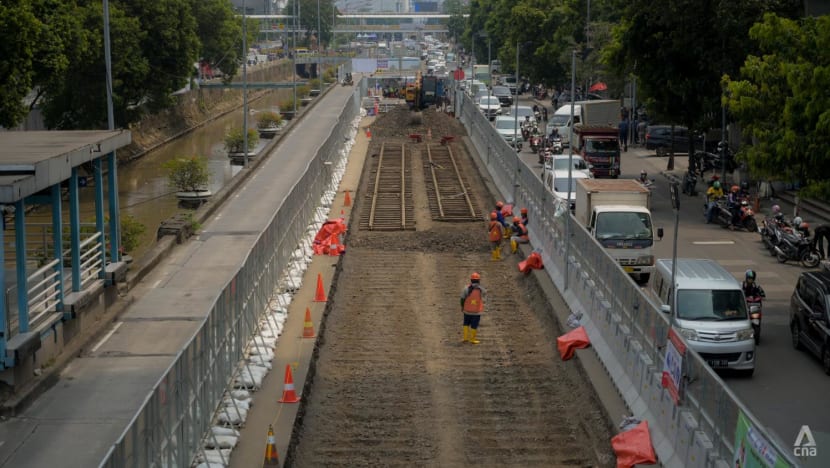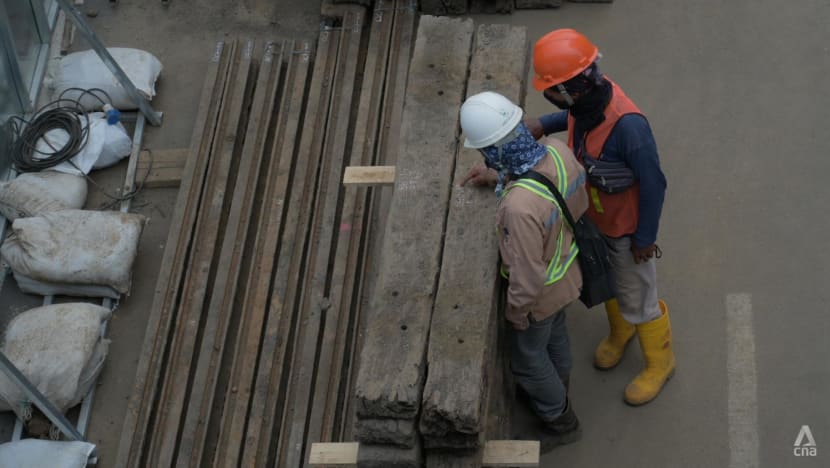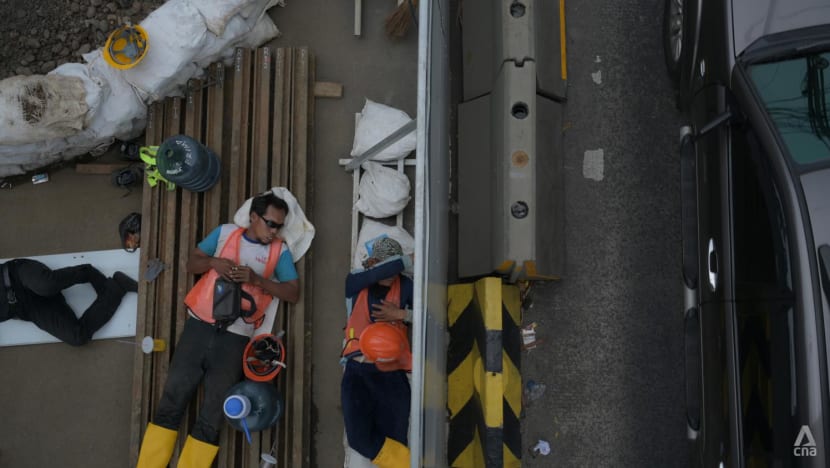‘I was very anxious’: Experts voice concern as work on Jakarta MRT expands into historical sites
The next phase of construction work for the rail line would cut through Indonesia's centuries-old neighbourhoods believed to contain many historical artefacts.

An MRT Jakarta construction site where workers discovered colonial-era tram tracks dating back to the 19th Century. (Photo: CNA/Nivell Rayda)
JAKARTA: Archaeologist Candrian Attahiyat remembered feeling anxious when construction for the second phase of Jakarta’s underground mass rapid transit (MRT) network began in 2020.
The 5.8 km rail line would connect Jakarta’s downtown area and the northern part of the Indonesian capital which means it would cut through centuries-old neighbourhoods which date back to the time when the city was ruled by the Dutch and known as Batavia.
“I was very anxious. I think everyone in the archaeological community felt the same way,” Mr Attahiyat, the head of Jakarta’s Cultural Preservation Team of Experts, told CNA.
Within months after construction began, Attahiyat’s fears were confirmed. Construction workers began discovering small historical artefacts in the form of ceramic fragments and bullets from the past eras.
As construction work progressed, bigger artefacts were found, said the conservation experts.
Since mid 2021, workers began discovering tram tracks which date back to the 19th Century, ancient underground pipes and foundations of a centuries-old bridge. The latest discovery occurred last month when workers unearthed a total of 1.4km of tram tracks in six locations.
A heated debate over the fate of these objects soon ensued.
Several archaeologists, including Attahiyat, believed that these historical objects should stay in their original positions. But MRT Jakarta argued that it would be very difficult to resume construction if these artefacts were not removed.
In the end, the railway operator only agreed to preserve a handful of objects which will not interfere with their work. Virtually all of the old tram tracks and underground terracotta pipes would have to be dismantled and removed.
“MRT Jakarta is working with a team of archaeological experts to devise ways to salvage the findings,” MRT Jakarta construction director Silvia Halim told reporters last month.
Halim said these objects would be documented and carefully dismantled before they are stored for safekeeping. MRT Jakarta also promised to provide spaces at upcoming stations where some of these objects will be displayed to the public.
After a long negotiation process, members of the archaeological community relented, at least for now.
But they remain anxious about the fate of the many artefacts still buried in Jakarta’s historical areas and possibly perturbed as construction for the underground railway continues.
DISMANTLING HISTORY
When CNA visited an MRT construction site in late November, much of the tram tracks along with their wooden beds had been removed from the dug asphalt road, leaving behind a layer of yellowish dirt muddied by the rain.
The imprint left behind by the tracks were the only reminder that up until the 1960s, trams used to operate in what now has become one of the city’s busiest traffic arteries.
At one end of the construction site were piles of salvaged steel tracks and stacks of wooden rail beds. The tracks were largely in good condition for something that has been buried for decades. Aside from a few traces of oxidation, there were hardly any signs of decay, cracks, twists or deformations.

“If we just leave (the tracks) there, they might get damaged from the MRT construction,” said Charunia Arni Listiya, an archaeologist from University of Indonesia who is leading the tram tracks’ excavation efforts.
Listiya added that since the tram tracks technically belonged to city-owned transportation operator Perum PPD, the findings will be taken to a Perum PPD storage facility.
Meanwhile, the terracotta pipes – dating back to the 17th Century – are now stored at an unused bus shelter near the construction site.
Attahiyat of Jakarta's Cultural Preservation Team of Experts said he had mixed feelings about the dismantling.
“I still feel that the tram tracks should be kept in their original position but I understand that this is technically difficult with all the construction going on. We have to make compromises,” he said.
HISTORICAL SIGNIFICANCE
The tram tracks were built by the Dutch in 1867, with one 10km line running from the oldest part of Batavia in the north to an upscale residential area where wealthy Europeans lived in what is now Central Jakarta.
Much of this original rail line, the oldest in Indonesia, intersects with the ongoing MRT construction project.
In its early days, the trams were horse-drawn. But horse trams were highly inefficient since horses could only work for a limited number of hours and had to be housed, groomed and fed. Then there was the issue of manure littering the streets of Batavia.
The horse trams were eventually replaced by steam powered ones in 1881. By 1934, the trams in Batavia were electric powered and the network had grown to cover much of the Dutch East Indies capital.
But trams were expensive to maintain and with Batavia transforming into a bustling city of Jakarta after Indonesia gained its independence in 1945, trams were going out of favour by city dwellers.
“Since trams had to compete for space with cars, buses and pedestrians, accidents were becoming more frequent as population grew,” historian JJ Rizal told CNA.
Trams were also unpopular in the eyes of some nationalists, including Indonesia’s first president and founding father, Soekarno, who saw them as remnants of Indonesia’s colonial pasts.
But removing the tracks proved to be too costly for the young nation. Thus, the tracks were simply abandoned and over time, buried underneath layers of asphalts before it was eventually forgotten by the general public.

Meanwhile, underground terracotta pipes were used all the way back to the 17th Century to channel clean water to homes and buildings in Batavia from nearby canals and centralised water storage facilities.
“These are important artefacts which can help people better understand the history of Jakarta,” Rizal said.
The Jakarta Cultural Agency commended MRT Jakarta for reporting the findings to the authorities and teaming up with the archaeological community to excavate the artefacts.
“What MRT has done is an important step in efforts to restore civilizations of the past,” agency chief Iwan Henry Wardhana told a discussion recently.
UNEASY FUTURE
MRT Jakarta currently operates a 15.7km line running from the Hotel Indonesia roundabout at the city centre to Lebak Bulus in the southwestern edge of Jakarta.
The second phase of construction would extend this line north all the way to the city’s historic area, Kota Tua. There are also plans to extend this line even further to reach the recreational area of Ancol in Jakarta’s coastal area.
The ongoing construction would add seven stations to the line, bringing the total to 20.
MRT Jakarta plans to open three of the seven stations in 2025, but the section which goes through the city’s heritage areas would not be operational until 2028.
Until then, the public will not get to see tram tracks and other artefacts being displayed at MRT stations adjacent to their original locations.
Historian JJ Rizal believes the long deadline has a silver lining.
“Until now, we have yet to see how the stations would be designed and how these historical objects would be displayed. (The long deadline) gives everyone the time to really think about how to best present these artefacts and the history behind them to the general public,” he said.

Meanwhile, Attahiyat of Jakarta’s Cultural Preservation Team of Experts is pondering the fate of artefacts which are still buried underground and possibly perturbed as construction continues.
Authorities are already having a hard time finding storage space for the 1.4km tracks excavated, he argued, and the salvaged tracks only made up a small fraction of the original tram network.
“If workers find more artefacts, will they be dismantled and removed like the others? People should get to see these artefacts in their original locations so they can appreciate (the objects’) historical and geographical contexts,” he said.
Attahiyat said he is torn about the ongoing MRT construction project.
“On one hand, it means more people get to visit Jakarta’s heritage areas. But it shouldn’t come at the expense of historical sites and artefacts,” he said.















